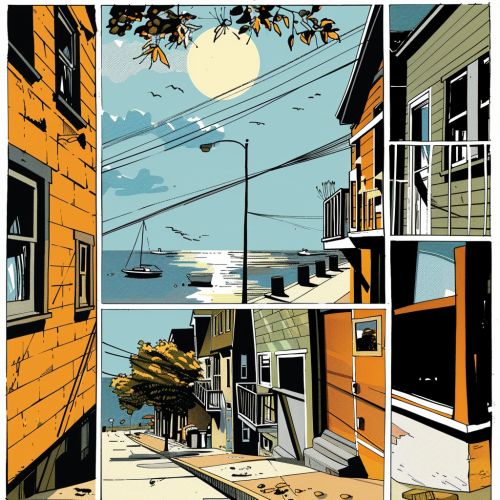Ligne claire
Introduction
Ligne claire (French for "clear line") is a style of drawing pioneered by Belgian cartoonist Hergé, the creator of The Adventures of Tintin. This artistic technique is characterized by its use of clear, strong lines of uniform weight, absence of hatching, and a preference for flat colors. Ligne claire has had a significant influence on the world of comics, particularly in European graphic novels, and has been adopted and adapted by numerous artists worldwide.
Historical Background
The ligne claire style emerged in the early 20th century, primarily through the works of Hergé. His clean, precise lines and minimalist approach to shading and detail set a new standard in the comic book industry. Hergé's influence extended beyond his own work, inspiring a generation of artists who admired his ability to convey complex narratives and emotions with simplicity and clarity.
The term "ligne claire" itself was coined by Dutch artist Joost Swarte in the 1970s, who recognized the distinctiveness of Hergé's style and sought to define it. Swarte, along with other artists such as Ted Benoit and Yves Chaland, became prominent figures in the ligne claire movement, further popularizing the style through their own works.
Characteristics of Ligne Claire
Ligne claire is distinguished by several key characteristics:
- **Uniform Line Weight:** The use of lines of consistent thickness throughout the drawing, which contributes to the clarity and readability of the artwork.
- **Absence of Hatching:** Unlike many other comic styles, ligne claire avoids the use of hatching or cross-hatching to create shading or texture. Instead, it relies on flat areas of color to define shapes and forms.
- **Flat Colors:** The use of solid, ungraded colors without gradients or blending. This enhances the visual clarity and simplicity of the images.
- **Minimalist Detail:** Ligne claire often eschews excessive detail, focusing instead on the essential elements needed to convey the story or scene.
- **Realistic Proportions:** Despite its simplicity, ligne claire maintains realistic proportions and perspectives, lending a sense of believability to the characters and settings.
Influence and Legacy
Ligne claire has had a profound impact on the world of comics and graphic novels. Its influence can be seen in the works of many contemporary artists and illustrators, who have adopted and adapted the style to suit their own creative visions.
One of the most notable aspects of ligne claire's legacy is its ability to transcend cultural and linguistic barriers. The clarity and simplicity of the style make it accessible to readers of all ages and backgrounds, contributing to its widespread popularity.


Notable Artists and Works
Several artists have made significant contributions to the ligne claire style, each bringing their own unique interpretations and innovations to the technique. Some of the most notable figures include:
- **Hergé:** As the pioneer of ligne claire, Hergé's work on The Adventures of Tintin remains the quintessential example of the style. His meticulous attention to detail and narrative clarity set a high standard for subsequent artists.
- **Joost Swarte:** A key figure in the popularization of ligne claire, Swarte's work is characterized by its playful, often satirical tone. He is also credited with coining the term "ligne claire."
- **Ted Benoit:** Known for his work on Ray Banana, Benoit brought a modern sensibility to ligne claire, blending traditional techniques with contemporary themes.
- **Yves Chaland:** Chaland's work is notable for its dynamic compositions and bold use of color. His series Freddy Lombard is a prime example of his mastery of the ligne claire style.
Techniques and Tools
Creating ligne claire artwork requires a specific set of techniques and tools. Artists typically use fine-tipped pens or brushes to achieve the uniform line weight characteristic of the style. Digital tools, such as graphic tablets and illustration software, have also become popular among ligne claire artists, allowing for greater precision and flexibility.
The process of creating a ligne claire illustration often begins with a detailed pencil sketch, which is then inked with clean, precise lines. Color is applied last, usually in flat, ungraded areas that enhance the clarity and readability of the image.
Applications Beyond Comics
While ligne claire is most closely associated with comics and graphic novels, its principles have been applied to other forms of visual art and design. The style's emphasis on clarity and simplicity makes it well-suited to fields such as illustration, advertising, and animation.
In illustration, ligne claire techniques are often used to create clear, easily understandable images for educational materials, technical manuals, and children's books. In advertising, the style's clean lines and bold colors can help to create eye-catching and memorable visuals. In animation, ligne claire principles can be seen in the work of studios such as Studio Ghibli, where the emphasis on clear, expressive lines and flat colors contributes to the distinctive look and feel of their films.
Criticism and Controversy
Despite its many admirers, ligne claire has also faced criticism from some quarters. Detractors argue that the style's emphasis on simplicity and clarity can sometimes result in artwork that lacks depth or complexity. Others contend that the uniform line weight and flat colors can make ligne claire illustrations appear static or lifeless.
However, proponents of ligne claire argue that these criticisms overlook the skill and precision required to create effective artwork in this style. They point out that the apparent simplicity of ligne claire is often deceptive, and that the best examples of the style are characterized by a high degree of craftsmanship and attention to detail.
Conclusion
Ligne claire is a distinctive and influential style of drawing that has left an indelible mark on the world of comics and graphic novels. Its emphasis on clarity, simplicity, and precision has inspired countless artists and continues to be a popular and respected technique. Whether in the pages of a comic book, an illustration, or an animated film, the principles of ligne claire offer a powerful tool for visual storytelling.
